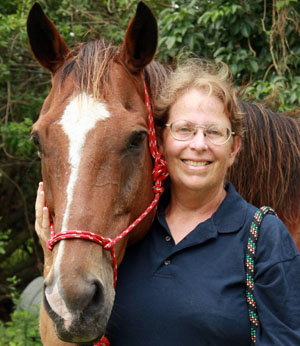TALES FROM THE TRAILS
I started out a skeptic and ended up a believer. When Amy Cedarburg works with a horse, it doesn’t look like anything’s going on. But looks can be deceptive.
Originally from Milwaukee, Amy moved to Tampa with her family when she was 11. Her family had run a dude ranch back in Wisconsin, and Amy missed riding. She begged and pleaded, and finally talked her parents into buying her a horse. She took lessons and showed until college, when they sold the horse. She spent the next 25 years of her life working as a flight attendant.
“I knew I needed to do something else with my life,” Amy said. “I went back to school at Palm Beach State College and graduated as a massage therapist in 2012. I also took a two-day course in something called cranio-sacral therapy or CST. I’d had pretty constant lower back pain since 2005, but when they used me for a demonstration, I was amazed when I woke up the next morning and the pain was gone.”
Amy found out that CST is also used on horses, which brought her full-circle back to her youthful love. In 2014, she took two horse CST classes and embarked on a new career.
“CST is a safe, effective therapy, which works by assisting the body’s natural healing processes,” she explained. “It removes or lessens the negative effects of stress on the central nervous system. Before I start a session, I approach a horse in neutral, which means I have no preconceived notions or agenda.”
CST is different from massage or chiropractic, she said.
“It’s a gentle, manual therapy done with a light touch, and it affects the whole body. Basically, the horse dictates what it needs and what I should do. I have to be patient and wait for the tissues to release the blockages,” Amy said. “I do a lot of work with horses’ faces. There are often impingements there, a lot of nerves and delicate bones. It’s a peaceful modality. Even though I’m mostly still and quiet during a session, it has profound effects.”
CST has its roots in osteopathy and can help such diverse conditions as head shaking, lameness, ulcers, back and neck pain, cribbing, TMJ problems and various injuries, both old and new.
“I work with and through the tissues to effect changes,” Amy said. “I start by going where there’s the least resistance, and then moving toward the more problematic areas. If the horse becomes very defensive or uncomfortable, I move to another area, wait for the sensitive part to soften, and then come back to it later.”
Amy has been working with a few rescue horses at Shannon Reilly’s Lazy Acres Farm in Loxahatchee Groves.
“Amy uses my horses as case studies,” Shannon said. “She started this past August. The horses are definitely a lot happier and relaxed. One of the older horses started putting on weight. They move better, a lot more freely. They all love her and fight to get worked on. I’d never heard of CST before, but I’d highly recommend it for any horse, even ones who are perfectly fine. You’ll definitely notice a difference in the horse’s well-being and happiness.”
Amy thoroughly enjoys her new line of work.
“I enjoy helping horses,” she said. “When I started with Shannon’s horses, I saw a big difference. One of them had ulcers. I’d start work on his hindquarters, and every time I moved toward his stomach, he’d do what I called chicken-kicking, kicking straight up toward his stomach. Slowly, that eased and then stopped altogether. Within a month, he also got a lot easier to catch.”
Amy has visited my house and worked on a couple of my rescues. One mare had chronic lameness issues, which had gotten so bad that at one point I considered having her put down. She gradually improved, but continued hobbling around the pasture, which was painful to both of us. I tried all the usual: vets, X-rays, medications, massage, chiropractic. Nothing worked, and no one knew the causes or cures for her lameness. Then Amy began working with her.
The operative word in that sentence is with. Amy allows each horse to say what it needs, and that’s what she does: no more, no less.
Amy stood with her hands on various parts of the mare’s body, apparently doing nothing. And yet, the mare reacted. By the end of each session, which lasted about an hour, the mare was yawning so hugely that her jaws were fairly creaking. The lameness diminished, and within a couple of weeks, I was able to do something I’d never imagined: ride the mare again.
Just as interestingly, some of the other horses in the herd stand as close to Amy as they can while she works on a horse, drafting off the calmness. They just about fall asleep from the relaxing energy. Some of them also ask to be worked on, and Amy always obliges. More than one horse in my herd has improved.
Once, Amy let me feel what she does. I placed my hands on a horse’s back, one behind the withers, one above the kidneys. Amy’s hands were on top of mine. I was amazed to feel the spinal fluid surge back and forth beneath the horse’s skin.
“This work is a passion for me,” Amy said. “I love seeing the changes, some of which are almost immediate. It amazes me that using such a simple, light touch can have such a strong, positive effect.”
My horses and I are all grateful. If you have a horse with problems, I can’t recommend Amy highly enough. You and your horses will benefit in ways you can’t even imagine.
For more information, call Amy Cedarburg at (561) 352-0630.








